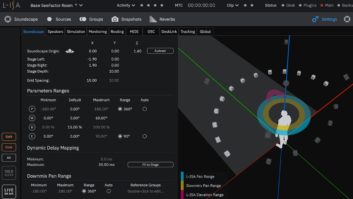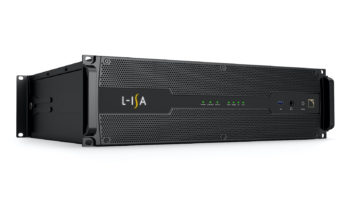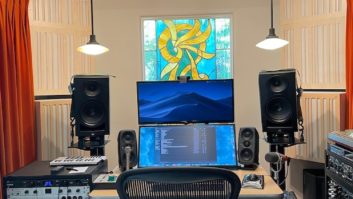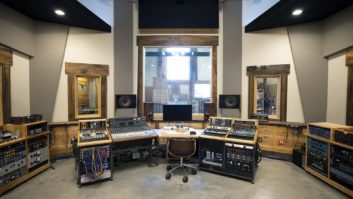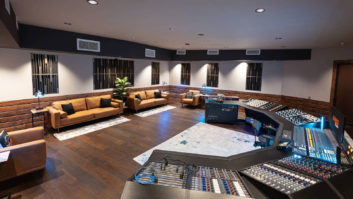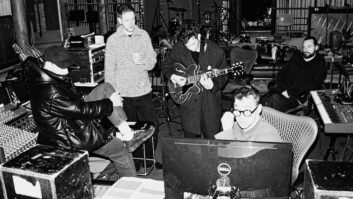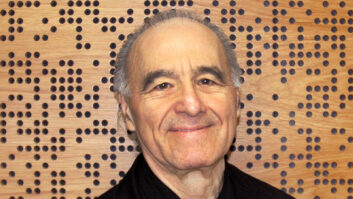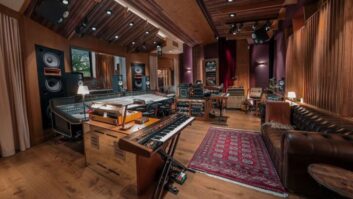Pro Sound News’ May 2013 cover story on small space acoustics covered additional topics and methods; here, writer Steve Harvey expands on them:
Easy access to inexpensive, good quality audio equipment now means that anybody can set up a studio in the home. But what may often be overlooked when converting a spare room or a garage into a production studio is acoustic treatment of the critical listening environment.
Part 2:
Dr. Peter D’Antonio, chairman/CEO of RPG Diffusor Systems, Inc., notes that his company’s Clearsorber Foil and Clearsorber DeAmp products are not applied directly to the glass. “You need a cavity,” he says.
An air cavity is, in fact, critical for most types of acoustic treatment. “Sound is a longitudinal wave that propagates in the direction that is oscillates,” he elaborates. “As this soundwave goes through a porous material, friction is created and the acoustic energy is converted to heat. That process is maximized when the particles are moving at their fastest velocity. That occurs when the soundwave is at a quarter of its wavelength.
“That’s why when you have a porous material on a surface, the particle velocity on the surface is zero. Some of the porous material that is mounted on the surface is merely there to support the material that isn’t on the surface. To increase your low frequency absorption, you have to move that panel away from the surface until you get to a distance that is a quarter of a wavelength for a lower frequency.”
D’Antonio points out that, contrary to the belief that corner bass traps are effective, the particle velocity is zero in the corner of a room: “It’s the absolute worst place to put a piece of porous absorption. You need to move this material away from the surface as much as possible.”
RPG’s Modex solves that problem by incorporating a membrane, he continues. “The velocity is zero on the surface but the pressure is at the maximum, so a low frequency membrane absorber is most effective when it’s on the surface. So you’d want to put a membrane absorber in the corner or even the trihedral corner—between the ceiling and the two walls—because that’s where the pressure is the maximum.”
A four-inch porous absorber, such as those offered by other companies, absorbs more frequencies than a one-inch panel, he says, “Simply because there are more low frequencies that have a contribution to the face of the panel. A one-inch panel can only absorb high frequencies because there’s no high particle velocity at the lower frequencies, especially in these small rooms. We make a whole series of Modex absorbers that are designed to be used in corners or on walls to absorb the modal frequencies.”
RPG maintains a research laboratory, says D’Antonio. “We can test every one of our panels in an impedance tube and we can get absorption in only four inches down to 40 Hz. That’s not achievable by any of these other products, despite what they say.”
“Bass trapping is very important to minimize the variation in response around the room, to reduce the ringing and to bring the peaks down and the nulls up,” says Ethan Winer, co-owner of acoustic products manufacturer RealTraps. Nulls are usually the bigger problem in a small space.
“The strongest reflections, probably the most damaging, come from the wall behind you. In a bedroom that’s six to 10 feet behind you, usually there are one or two really deep nulls somewhere between 60, 80, 120 Hz,” he says.
An untreated small space will cause the engineer to overcompensate in various ways—adding too much or insufficient EQ, for instance, or too much or too little reverb. “It’s really important to absorb those reflections. Clarity is increased greatly, and the stability of imaging is also increased enormously. That lets you hear very small changes in panning, in EQ and in reverb,” says Winer.
“Most diffusors are made out of lightweight Styrofoam, in which case bass passes through them to the wall and then reflects, or they’re made of wood, in which case the diffusor reflects. Our diffusors are made out of bass trap material; it’s a rigid fiberglass with a thin reflecting membrane in front. That sits on a 2-ft. x 2-ft. bass trap. These are six inches thick, so they free stand.” Bass traps do the most good in corners and flat on the back wall, he says.
“Adding the membrane increases bass absorption about 50 percent. It also is semi-reflective at mid and high frequencies. When you have bass traps in corners, they’re out of the way of reflection points, so a little reflection is okay. And that way, you can put a pile of bass traps in the room and not make it dead.”
Absorption should be placed on the side walls at the reflection point between each monitor and each ear. “It’s basically about halfway between you and the speakers. You have a friend take a hand mirror and slide it along the side wall, and where you can see the front grille of the speaker, that should be covered with absorption, and a foot or two outside of that area.
“We have a lot of articles and videos on the web site that show these principles. There’s an article on our web site, ‘How to Set up a Room;’ it shows that you want the speakers firing the longer way down the room, and it shows graphs of the bass response both ways,” says Winer.
He continues, “I’ve seen people recommend diffusors at reflection points. I’ve tried that and it always sounds worse to me than absorption. The standard place for diffusion is generally the one-dimensional QRD [quadratic residue diffusor] type on the back wall. Using diffusion at reflection points is a misguided audiophile thing.”
According to Delta H Design, Inc. (DHDI) company principal Hanson Hsu, his ZR Micro products were created as the direct result of a customer’s budget restriction. “We had a client who didn’t want to spend any more money on a rental building. They had a 10-year lease and they didn’t want to invest money into permanent construction. They had heard me talk about conceptual ideas for hang-on-the-wall products, and pressed us very hard. In four months, we brought four products to the market last year: Micro, Sample Rate, Prefab and Nomad, a studio in a shipping container.”
ZR Micro comes in five designs: Sunspot, Loma, Toccante, Blackhole, and Horizon. “They have the same resolution and do the same functions, but the direction in which they send sound, the control, and sculpting, is all different based upon the designs. With five designs, where you put them and how you arrange them in a room is very important. We’ve designed three packages [Classic, Plus and Virtuoso] where all you have to do is hang them according to the maps that we have online,” says Hsu.
“Beside the transportability of function and economy of it, we assume people are going to have a studio that is in a bedroom or garage with parallel walls, and therefore we designed the product around the ease of hanging it like a painting. The hard part is where you hang it, and in what order you hang what designs; hence, the packages,” he adds.
ZR Micro panels are 2 ft. x 2 ft. and cloth covered, like many acoustic products. With Sample Rate, on the other hand, “We wanted to offer something that inherently had an artistic aesthetic value, while increasing the acoustic resolution. The idea was that Sample Rate should be landscape format, because no one is doing that. And it’s really, really thin. We make them out of a composite board; we have options for walnut and ebony.”
Micro and Sample Rate work through sonic demodulation, Hsu explains. “They do an FFT, but instead of giving you pure tones, they give you white noise. They both do that in different ways. Using very high resolution, we control the sound so that it drops low enough that you don’t hear it, we send it places where you’re not going to hear it, and it bounces off the room in a certain way. It basically makes everything go away from you and drops the amplitude and controls the waveform by splitting it into lots and lots of little pieces that are more controllable.”
He notes, “They’re full bandwidth; there’s no Helmholz, there’s no partial frequency. You chop the waveforms into tiny pieces, and control them and sculpt the sound. It’s much more effective.”
Hsu comments that in an industry—indeed, a world—where everything is quantified, there is no generally accepted measure of the effectiveness of acoustic treatment. “It sounds better, it sounds worse,” is as far as quantification is normally taken, he says. “So we quantified it: non-parallel surfaces [NPS] per square foot. You count the square footage in your room—the ceiling, the walls, the floors—count the non-parallel surfaces and do the math.”
On the DHDI web site, Sample Rate is given a rating of 450+ NPS/sq. ft., and Micro a figure of 140+. “Micro has 14,000 times the acoustic resolution of a traditional recording studio, and over 1000 times of our custom ZR designs. Sample Rate has something like 45,000 times the resolution [of a traditional design],” he explains.
There are those unwilling or unable to buy a full room package, he says. “We have had clients who buy just a front wall for economy. They’re used to having one sweet spot, so they get a lot of performance out of that.”
The next challenge, it seems, is the ubiquitous monitor screen. “The thing that’s killing acoustics is the advent of multiple video monitors in rooms. We’re working on acoustical designs for architectural glass as well as the reflections off glass,” he shares.
D’Antonio observes that many acoustic treatment manufacturers focus on the room modes: “It’s a simple calculation; they have spreadsheets that calculate the modes. They try and get a uniform distribution of the modes. But it really doesn’t correlate 100 percent with what we hear.”
RPG developed two software programs, he reports. “We created a program called the Room Sizer; we don’t sell it any more. It describes appropriate modal dimensions. These modal ratios are a function of the volume of the room, so a room of a certain volume might be good at 3:4:5, but in a different volume room that wouldn’t work as well.”
When building from scratch, he continues, “The first thing you need to do is get your room dimensions properly. Even if you don’t do that, what people have to realize is that the position of the loudspeaker determines which modes are energized. For example, if you put your loudspeaker in a trihedral corner, you will energize all the modes in the room. If you put the speaker in the centroid of the room, you will not energize all the modes, because you will be at the null of certain modes.”
He elaborates, “If you turn a signal generator on to the fundamental mode of the room, as you locate yourself on one wall, the pressure will be really high. When you get to the center of the room, the first mode will be inaudible because you’re at a null. That’s true for all the odd-order modes.”
A second program, Room Optimizer, recommends exactly where to put loudspeakers and to position the listener. “We used that when [renowned mastering engineer] Bob Ludwig was designing his room. I sent him the coordinates. He said, ‘I put it there, then I did my own tests, and dammit if it wasn’t exactly where I would have put it!’”
There is another way to control room modes, D’Antonio points out: “You can position four subwoofers, and even two in some cases, to completely mitigate the modal problems that you have in your room. Typically, there’s a very special position in a room, which is a quarter, a quarter and a quarter from room boundaries. This is not often possible in rooms, and there are other solutions, but if you could put two subwoofers at 1/4, 1/4, 1/4 and 3/4, 3/4, 3/4 [of the distance between walls] and played them in phase those subwoofers would cancel the modes in such a way that you could literally move across the console and not experience any low frequency anomalies.”
Over the course of RPG’s 30 years in business, customers have gotten the impression that the company’s products are out of reach, D’Antonio comments. “If there’s anything we’ve done right, it’s that we’ve convinced the world that our products are unaffordable,” he laughs. “Because we have a research lab, we get to work with all the prominent studio designers, so people think our products aren’t affordable. The reality of the situation is that about 70 percent of our business is in schools.”
Over that same period, RPG’s research has identified shortcomings of the original QRD design, leading to new, improved products. Working toward the design of its new Modffusor, he says, “We’ve developed an ISO standard to test diffusion. When we say something, we have a parameter to measure it. The Modffusor is essentially the end of the line in the evolution of number theoretic diffusors.”
Modffusor was designed at least in part as a response to other companies borrowing the original QRD design. “As QRDs began to be copied, we developed the Modffusor. We developed a plank called FlutterFree, which is a one-inch-thick plank that we sell by the mile.” A version of each has been patented, he says. “Our BAD panel is being ripped off, so we patented a new sequence. We like to say that we deal with imitation through innovation.”
Delta H Design, Inc.
deltahdesign.com
RealTraps
realtraps.com
RPG Diffusor Systems, Inc.
rpginc.com
